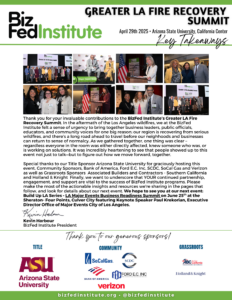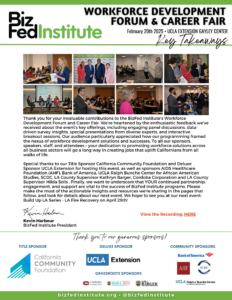The BizFed Institute convened more than 100 top business leaders at Woodbury University in Burbank Wednesday for a frank and spirited discussion of the opportunities and challenges associated with accessing the massive oil and gas deposits contained in the Monterey Shale formation, located primarily in California’s Central Valley. Over the course of three hours, participants heard directly from leading economic, regulatory, environmental, and industry experts.
WATCH VIDEO excerpts of the forum – Click HERE.
“The BizFed Institute brings together diverse and sometimes conflicting voices to have frank and mature conversations about challenging issues affecting our communities and our economy, and that’s exactly what we’re doing today,” said David Fleming, BizFed’s founding chair. Fleming argued in remarks during the forum that California will have no choice but to access the Monterey Shale’s energy resources to help America ultimately become a net energy exporter.
Kevin Hopkins, director of research with The Communications Institute, presented the findings of the in-depth economic study of the Monterey Shale, which he co-authored. The report, “Powering California: The Monterey Shale & California’s Economic Future,†cosponsored by the USC Viterbi School of Engineering and the Price School of Public Policy with The Communications Institute, details the economic potential of the Monterey Shale, including up to:
•       $24.6 billion in new state revenue
•       2.8 million new jobs
•       $222.3 billion in new personal income
•       14.3% increase in state GDP
Hopkins made clear that the report did not examine any environmental issues related to accessing energy resources in the Monterey Shale, and he acknowledged that more research must be done to ensure those issues are addressed.
Moderated by Susan Kennedy, former Schwarzenegger Administration and Davis Administration senior official, the panel discussion created a critical opportunity for open dialogue between industry, environmental advocates, and regulators. Her key takeaway from the discussion was that, before addressing the details of hydraulic fracturing, or fracking, California must first decide whether to extract its own oil and gas resources or continue to import them from other countries. It was noted that over 60 percent of California’s transportation fuel energy comes from outside of the state and the country.
The panel Kennedy moderated included Tim Kustic, California’s state oil and gas supervisor, Bill Allayaud, California director of governmental affairs for the Environmental Working Group (who joined via Skype from Sacramento), and Catherine Reheis-Boyd, president of the Western States Petroleum Association.
Kustic made the point that, after 60 years of hydraulic fracturing in California, state regulators are not aware of any incidents of groundwater pollution or any other ill effects. He provided detailed insights from the perspective of state regulators, elaborating on some of the technical questions that had been brought up throughout the morning. He supported his agency’s work, noting that their legislative mandate is to ensure public and environmental safety while also enabling access to California’s oil, gas, and geothermal sources.
Allayaud explained that, rather than initially seeking a ban or moratorium on hydraulic fracturing, the Environmental Working Group is first trying to ensure the state regulates the practice in a way that promotes transparency and accountability and protects public health and safety. He confirmed that environmentalists are not responding to reported problems from hydraulic fracturing in California. Rather, they are seeking to ensure we get on top of the process to avoid any chemical pollution or water supply issues with a possible increased use of hydraulic fracturing or other forms of well stimulation, such as acidizing. However, he also criticized state regulators for not doing enough over the years to identify where fracking is occurring and what chemicals are used in the process. He questioned whether, without knowing what chemicals to look for, the state can really say that there have been no cases of environmental contamination. He also questioned the results of the USC economic study on Monterey Shale, which Hopkins vigorously defended from the audience.
Reheis-Boyd detailed California’s rising demand for oil and gas, explaining that nearly all oil and gas produced in California is used in California. She explained that the current demand far outpaces the in-state supply, and she noted that allowing access to the Monterey Shale reserves would create millions of new jobs. On the issue of hydraulic fracturing, she reiterated the industry’s long history and strong safety record in California and highlighted the industry’s voluntary efforts to publicize the chemicals used in the process. She also reinforced the point that hydraulic fracturing is merely one method of accessing shale reserves, as is horizontal drilling. The combination of the two technologies makes accessing the Monterey Shale more viable.
In each case, and throughout the discussion, Kennedy pressed each panelist to clarify their points, truly respond to critiques from other panelists, and validate their facts and positions, ensuring a full and open exchange.
At the beginning of the program, Mark Nechodom, director of the California Department of Conservation, set the stage with an overview of the energy potential contained in the Monterey Shale formation, which lies 3,000 feet below ground level, primarily in the Central Valley. He noted that hydraulic fracturing is merely one method of accessing those oil and gas resources. Nechodom explained that, while hydraulic fracturing has been happening in California for decades, the Brown Administration is working to ensure new regulations will continue to protect the environment while enabling access to this California formation that constitutes two-thirds of all shale reserves in the United States.
“The Institute is a complement to BizFed, engaging civically minded, nonprofit, academic, and regional thought leaders for the purpose of building strong communities propelling a robust economy,†said Tracy Rafter, BizFed CEO. “True to BizFed form, we don’t shy away from the interesting, the challenging, the diverse, or the outliers. Rather we get motivated, get connected, get informed and engaged.â€




